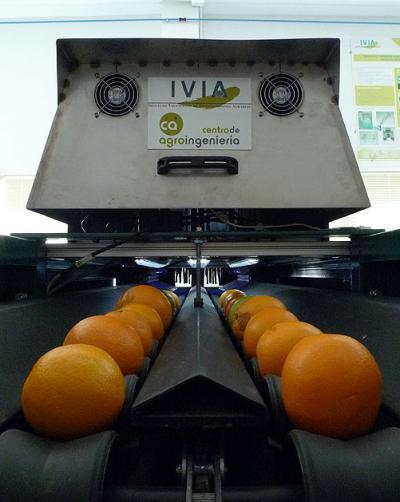Scientists at the Valencian Institute of Agrarian Research (IVIA, Spain) have created prototypes for machines that not only detect and automatically separate rotten oranges, but can also detect mandarin segments according to quality and helps citrus fruit pickers out in the field. All the prototypes use computer vision to automatically inspect the fruits.
They basically created software that allows a computer to be programmed so that it "understands" the image it has in front of it and can act accordingly. The fruit sorting prototype uses visible light and classifies citrus fruits on the production line according to their quality, coloring and the type of damage that the skin presents. In this way, first class fruits that are destined for more demanding markets can be separated from second class fruits that are perfectly edible despite having some small defect like being bruised or scratched. The analysis is carried out at a speed of 15 to 20 pieces of fruit per second.
The prototype for the inspection of ready-to-eat mandarin segments is able to examine 28 segments per second. At this stage, the broken segments are separated from the whole segments and the same goes for those with or without pips. Skin and any other foreign bodies are also identified and eliminated from the production line.

Citrus fruits classified on the production line. Credit: IVIA
José Blasco, researcher at the IVIA and a member of the team that patented the machine, said that "as well as developing property statistical and computing techniques, the prototypes use the highest image resolution that modern equipment can achieve. They are capable of analysing objects in regions of the electromagnetic spectrum that the human eye
cannot see such as ultraviolet and infrared.
"We have even started to inspect the internal quality of fruit using magnetic imaging resonance (MRI), computerized axial tomography (CAT) or X-rays, like those that are used in medicine," he adds. "Although at the moment, these are costly techniques and we must continue in our investigations so as to facilitate their installation and make them more efficient in the fruit selection process."
One of the latest investigations focuses on the use of hyperspectral imaging, which collects and processes information from a large part of the electromagnetic spectrum and provides individual spectral measurements for each pixel. This method can be applied as a way of identifying chemical compounds whose concentrations can change as the fruit ripens or rots. Therefore, it is possible to predict the perfect time to eat the fruit or, indeed, to track the evolution of a disease in the fruit.
The most sizeable of IVIA's projects is a machine that helps during the picking of citrus fruits and it is the size of a large tractor. Blasco highlights that it is a self-propelled prototype capable of classifying oranges whilst still out in the field. As a result, he states that "it is very important that the inspection system is highly efficient from an energy consumption point of view."
Operators pick the fruits and place them on the machine's mobile belt. Quality, color and the presence of external damage is determined using sensors and a vision system.
The information gathered by the sensors is then transmitted to an automated logic controller in order for the fruit to be classified into the three established categories. Upon arrival at the warehouse, the fruit has already been preclassified and comes with complete statistics on its quality. This allows for it to be valued and its immediate destination can be decided upon.
The results have been published in the Food and Bioprocess Technology journal.





Comments